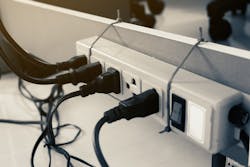Plug loads are becoming one of the fastest growing end uses of energy, the New Buildings Institute warns, and their drain on energy budgets is on the rise.
This group includes any devices that plug into a building’s electrical system. In a typical office, the worst offenders are desktop equipment such as computers, monitors, and printers, notes Suzanne Foster Porter, previous director of research and technical services for Energy Insight (formerly ECOVA), an energy and sustainability management firm.
Small offices also see a disproportionate amount of their plug load stemming from IT closets and computer rooms.
Fortunately, occupant participation and low-cost technology can shave up to 40 percent off of your building’s plug load. Could one of these six ideas help unlock savings at your facility?
1. Dispel Common Myths
Many people still believe that turning computers off and then on again uses more energy than just leaving them on, Foster Porter notes. Start improving occupants’ energy behavior by providing facts and figures about why your organization is pushing for lower energy consumption.
“It’s important to have training for how to manage power at your workstation,” Foster Porter says. “This can be done in a variety of ways, including IT onboarding, but it should be specific to what has been implemented in that person’s space. The point isn’t just to say what someone should do, but to tie it back to the company mission and why you’re trying to reduce energy use in the first place – for example, ‘We’re doing this to cut costs’ or ‘We’re doing this to walk our talk on being green.’”
[Try these: 3 Energy Management Games for Your Facility]
2. Use Better Computer Settings
The default energy settings on many computers aren’t very efficient, and occupants may overestimate how much energy they’re saving.
Using standby mode while away from the computer helps. However, some may believe their computers are saving energy on standby when their absence actually just puts the computer in idle mode.
This means after a certain number of minutes without use, the screensaver appears or the screen goes black, but the computer is still running at full power waiting for its owner to come back.
Help BUILDINGS Shape 2019!
What BUILDINGS resources are most valuable to you? What would you like to see us provide?
Please take our short (under 2 minutes) survey - just 5 short questions.
Thank you!
“There’s not that much difference between standby and off because if a computer is truly in standby mode, it’s using less power,” Foster Porter says. “But users don’t do a great job of powering down unless they’re supported with some low- and no-cost technologies. You can implement better power management settings using software that already comes with your computers.”
3. Scale Up to Enterprise-Level Software
Though the power management software packaged with new computers can make a sizable dent in energy consumption, it also offers occupants an easy override opportunity.
“Users can change the individual power management settings on their own without necessarily understanding the implications of that change,” explains Foster Porter.
“If I’m tired of my computer going to sleep after 15 minutes of not being used, I can change it so it never goes to sleep, but that completely negates the power savings possible in sleep mode. Enterprise-level power management software allows users some personal control, but sets boundaries. For instance, you can have the computer turn off after four hours of inactivity so that at least it goes to sleep at night,” she continues.
4. Try Smart Plug Strips
Consider supplementing power-saving settings with special plug strips that use timers, load sensors, or occupancy sensors to shut off power to certain devices when no one is using them.
A strip with a timer can reduce energy at night and over weekends, while one with an occupancy sensor could be used to shut off some devices (such as speakers or the monitor) when no one is present. Some models cut power to selected peripherals whenever the computer enters, sleep, standby, or disconnected mode.
BUILDINGS Education
3 Plug Load Control Solutions
See how much you can save by implementing a plug load control strategy and more - plus get CE credits.
“This still requires behavior intervention in terms of showing occupants the plug strips and explaining what they do, but the technology supports their actions,” says Foster Porter. “They don’t personally have to turn off the printer, speakers, and monitor.”
5. Centralize Equipment
Imaging equipment like printers, scanners, and fax machines are the third biggest contributors to plug loads, Foster Porter says. If your office has dedicated printers for every desk, consider purchasing a shared one and putting it in a central location.
This strategy offers an added cost savings, as maintaining one communal printer requires much less time and labor than multiple small ones.
6. Work with IT on Purchasing
Team up with your counterparts in the IT department to make sure energy performance is included in procurement specs for future technology purchases. ENERGY STAR certified equipment is a good start, but in some cases, you may be able to find devices that use even less energy than the ENERGY STAR cap.
“Ensure that the performance specifications are well matched with what each workstation needs,” recommends Foster Porter. “If someone is only using a computer for email, light word processing, and surfing the Internet, they could switch to a Mini PC instead – it’s less costly than a laptop but has similar functionality in terms of processing power and speed of memory. Those are an option for many workstations where big computing isn’t required.”
Two handpicked articles to read next:
About the Author
Janelle Penny
Editor-in-Chief at BUILDINGS
Janelle Penny has been with BUILDINGS since 2010. She is a two-time FOLIO: Eddie award winner who aims to deliver practical, actionable content for building owners and facilities professionals.


